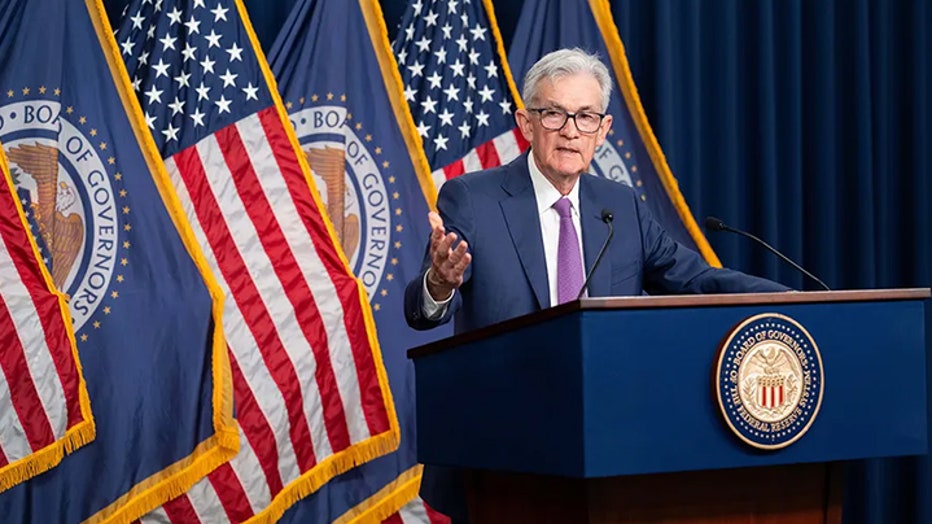Fed holds interest rates steady, projects just one cut this year
Fed holds interest rates steady
The Federal Reserve said Wednesday that interest rates would again remain unchanged. Chair Jerome Powell spoke about the decision.
The Federal Reserve on Wednesday held interest rates steady for the seventh straight time and scaled back the outlook for rate reductions later this year as high inflation lingers.
New quarterly economic projections laid out after the meeting show that a majority of Fed officials who participated expect rates to fall to just 5.1% by the end of 2024, suggesting there will only be one quarter-point rate cut this year – a sharp reversal from the three they had predicted in March.
In their post-meeting statement, policymakers left the door open to rate cuts but stressed they need "greater confidence" inflation is coming down before lowering borrowing costs.
While inflation has fallen considerably from its peak, price pressures have proven more stubborn than expected. The Fed's favorite gauge shows that inflation is running at a 2.7% pace – well above the central bank's 2% goal. When excluding food and energy, underlying core inflation came in even hotter at 2.8%.
RENT PRICES ARE STAGNATING, SUGGESTING HIGH INFLATION MAY STICK AROUND
Earlier in the day, the Labor Department reported that the consumer price index (CPI), a broad measure of how much everyday goods like gasoline, groceries and rent cost, was unchanged in May from the previous month. Prices climbed 3.3% from the same time last year.

Federal Reserve Chair Jerome Powell attends a press conference in Washington, D.C. on May 1, 2024. (Credit: Liu Jie/Xinhua via Getty Images / Getty Images)
Another data point that measures underlying inflationary pressures within the economy also moderated last month. So-called core prices, which exclude the more volatile measurements of gasoline and food in order to better assess price growth trends, increased 0.2% in May. From the same time last year, the gauge climbed 3.4% – the lowest reading since 2021.
AMERICANS' INFLATION EXPECTATIONS CREEP HIGHER AGAIN, KEY NY FED SURVEY SHOWS
Altogether, the report indicates that inflation is loosening its stranglehold on the U.S. economy, though prices remain well above the Fed's 2% target.
"We see today's report as progress and building confidence," Fed Chair Jerome Powell told reporters at the post-meeting press conference in Washington. "But we don't see ourselves as having the confidence that would warrant beginning to loosen policy at this time."
THESE US CITIES HAVE THE BIGGEST INFLATION PROBLEMS, STUDY FINDS
Policymakers raised interest rates sharply in 2022 and 2023 to the highest level in more than two decades in a bid to slow the economy and cool inflation. Officials are now grappling with when they should take their foot off the brake. They entered 2024 expecting to reduce rates at least three times this year, but have repeatedly pushed back their plans, even though inflation eased in both April and May.
Federal Reserve holds interest rates
Inflation in the U.S. eased in May for a second straight month. LiveNOW from FOX's Andy Mac caught up with financial planner David Ragland to discuss the latest.
INFLATION RISES 3.3% IN MAY, LESS THAN EXPECTED
The fresh forecasts laid out Wednesday illustrate that many central bankers are bracing for stickier inflation this year. Officials predicted that inflation will cool to just 2.6% at the end of 2024 – higher than their 2.4% forecast in March – before falling to 2.3% in 2025.
Still, Fed policymakers tweaked their statement to say there has been "modest further progress toward the Committee's 2 percent inflation objection," a change from last month, when they said there had been "a lack of further progress" on combating high prices. They penciled in four rate cuts in 2025, an increase from March, when they predicted three reductions.
Higher interest rates tend to create higher rates on consumer and business loans, which then slows the economy by forcing employers to cut back on spending. Higher rates helped to push the average rate on 30-year mortgages above 8% for the first time in decades last year. Borrowing costs for everything from home equity lines of credit, auto loans and credit cards have also spiked.
Yet the rapid rise in rates has not stopped consumers from spending or businesses from hiring. The labor market is continuing to chug along at a healthy pace, with employers adding 272,000 new workers in May. Job openings also remain higher than the typical pre-pandemic level, although the unemployment rate recently ticked higher to 4%.
Find more updates on this story at FOXBusiness.com.

